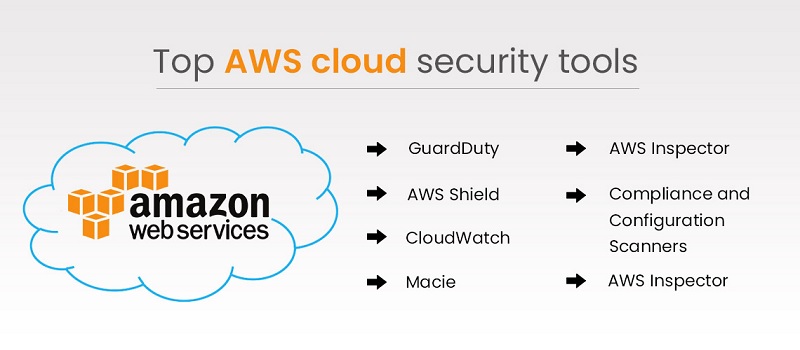Table of Contents
- Keeping Your AWS Environment Secure with AWS Inspector
- Leveraging AWS Web Application Firewall for Increased Security
- Utilizing AWS Config to Monitor and Secure Your Cloud Environment
- Understanding the Role of AWS Identity and Access Management in Security
The world of cloud computing is rapidly evolving and the need to protect data and assets is ever-increasing. As businesses move to the cloud, the need for secure cloud environments increases. AWS (Amazon Web Services) is one of the top cloud providers and offers a wide range of security tools to help you protect your data. In this article, we will discuss some of the best AWS security tools that you must try. We will discuss the features of each tool and how they can help you secure your cloud environment.
Introduction to AWS Security Tools and the Benefits They Offer
AWS, the Amazon Web Services platform, has become an increasingly popular cloud computing resource. To help users securely manage their cloud-based infrastructure, AWS offers a wide range of security tools. These tools can be used to protect data, applications, and other resources stored in the cloud. AWS Identity and Access Management (IAM) is a key security tool. It enables organizations to create user accounts and assign access rights for using AWS services. With IAM, users can control which users can access which resources and how they can access them. This helps to prevent unauthorized access and data leakage. AWS CloudTrail is another security tool offered by AWS.
It records API calls made to AWS services, allowing users to track the actions of the users, applications, and services that access their AWS resources. This helps organizations to monitor and audit their cloud-based environment and detect any suspicious activities. AWS Config is another security tool. It provides users with a detailed view of their AWS resources and their configurations. It also helps to ensure that resources are configured according to security best practices. Additionally, AWS Config enables users to detect any changes in their AWS environment and take appropriate action.
Finally, AWS Security Hub is a security tool that centralizes security alerts from a variety of sources, including AWS services, partner solutions, and customer-defined rules. This helps organizations to quickly identify any potential security issues and take action to address them. The security tools offered by AWS are designed to help users protect their cloud-based resources. These tools can help organizations to reduce the risk of data breaches, detect suspicious activities, and ensure that their resources are configured according to security best practices. Additionally, the tools help organizations to quickly respond to any potential security threats.
Keeping Your AWS Environment Secure with AWS Inspector
AWS Inspector is a powerful security service from Amazon Web Services (AWS) that provides automated security assessments to help identify and address potential security vulnerabilities in your AWS environment. With AWS Inspector, organizations can stay ahead of security threats and ensure their AWS environments are always secure. AWS Inspector identifies security issues by analyzing the configuration of your AWS resources and comparing it against security best practices. This helps you quickly identify and address configuration issues that could leave your environment open to attack. AWS Inspector also performs runtime analyses of your resource behavior to detect anomalies that could indicate malicious activity or resource misconfigurations. AWS Inspector offers several features to help secure your AWS environment:
1. Asset Discovery & Inventory: AWS Inspector identifies all the assets in your AWS environment and provides detailed information on each asset. This includes information such as the operating system, software versions, and security configuration.
2. Rules-Based Security Assessment: AWS Inspector provides a set of rules-based security checks that identify potential security vulnerabilities in your AWS environment. These checks can help you identify misconfigurations that could leave your environment open to attack.
3. Continuous Security Monitoring: AWS Inspector offers continuous security monitoring that looks for changes in your environment that could indicate malicious activity. This helps you quickly identify potential threats and take corrective action.
4. Security Reports: AWS Inspector provides detailed reports on the security posture of your AWS environment. These reports include recommendations for addressing any identified security issues. By using AWS Inspector, you can proactively identify security issues and take the necessary steps to secure your AWS environment. This helps you reduce the risk of a data breach or other security incident in your AWS environment.
Leveraging AWS Web Application Firewall for Increased Security
The Amazon Web Services (AWS) Web Application Firewall (WAF) is an important tool for increasing security on web applications. It provides a layer of protection from malicious actors and helps protect web applications from malicious attacks. The AWS WAF works by analyzing incoming web traffic and blocking requests that match specific criteria. It can be configured to block requests based on IP address, geographic location, HTTP headers, and more.
It can also be configured to block certain types of malicious requests, such as SQL injection or cross-site scripting attacks. The AWS WAF also provides visibility into the traffic that is being blocked. It can provide detailed logs of the requests that have been blocked, as well as the IP addresses of the malicious actors. This can help to identify malicious actors and take appropriate measures to mitigate the threat. The AWS WAF also provides additional security benefits.
For example, it can be used to create custom rules that can help protect applications from specific types of malicious activity. Additionally, it can be used to rate-limit requests from certain sources to help ensure that applications are not overwhelmed with too much traffic. The AWS WAF is a powerful tool for increasing the security of web applications. By leveraging its features, organizations can protect their applications and data from malicious actors and reduce the risk of security incidents.

Utilizing AWS Config to Monitor and Secure Your Cloud Environment
AWS Config is a powerful tool for monitoring and securing your cloud environment. AWS Config provides a detailed view of the configuration of your resources and can help you identify and monitor compliance with your organization’s policies and regulations. This article provides an overview of AWS Config and how it can help you ensure the security of your cloud environment. AWS Config is a service that records the configuration of your AWS resources, such as Amazon EC2 instances, Amazon S3 buckets, and Amazon VPCs. AWS Config provides a comprehensive view of the configuration of your environment, including all changes made to your resources.
This includes changes to their security groups, IAM roles, and network access control lists. AWS Config also includes detailed information about the resource’s resource type, resource ID, and the region where it is located. AWS Config also includes a built-in compliance engine that can help you identify resources that are out of compliance with your organization’s policies and regulations. This engine can detect issues such as public access to S3 buckets, IAM roles without MFA, and unencrypted S3 buckets. AWS Config also provides detailed reports on the configuration of your resources, allowing you to identify trends and anomalies. AWS Config also provides an alerting system that can notify you when changes are made to your resources.
This alerting system can be configured to send notifications to specific users or groups, or to a specific email address. This system is especially useful for detecting unauthorized access or changes to your resources. Finally, AWS Config provides a detailed audit log of all changes made to your resources. This audit log can be used to identify who made a change, when it was made, and what type of change was made. This audit log can be used to identify trends in configuration changes, and can be used to detect potential malicious activity.
Understanding the Role of AWS Identity and Access Management in Security
AWS Identity and Access Management (IAM) is an important security tool for Amazon Web Services (AWS) customers. It is a web service used to control access to AWS resources. IAM enables customers to manage users and their level of access to AWS resources. IAM allows customers to create multiple users for their AWS account and to control their access to specific resources. It also provides a range of features to help customers maintain secure access to their resources. These features include user and group management, multi-factor authentication, access control policies, and audit logging.
Using IAM, customers can grant and deny access to specific AWS resources. This ensures that users have access only to the resources that they need to do their job. This helps to prevent users from accessing sensitive data or making unauthorized changes. IAM also provides customers with the ability to set up multi-factor authentication. This requires users to provide two or more forms of identification, such as a password and a code sent to a mobile device. This helps to prevent unauthorized access to AWS resources. Finally, IAM provides customers with detailed audit logging.
This provides customers with a complete record of all changes made to their AWS resources and access control policies. This helps customers to identify potential security issues and take appropriate action. Overall, AWS IAM is an important tool for managing access to AWS resources and maintaining a secure environment. By using IAM, customers can ensure that users have access only to the resources that they need and that unauthorized access is prevented.
Quick Summary
Overall, it is clear that the best AWS security tools are those which provide comprehensive security for all aspects of the cloud infrastructure, from network and data protection to identity and access management. With the right combination of tools, AWS customers can ensure their cloud environment is secure and properly monitored. The tools mentioned in this article are just a few of the many available, and the selection should be based on the specific needs and requirements of the customer. By leveraging these tools, customers can enjoy a secure and reliable cloud environment.
